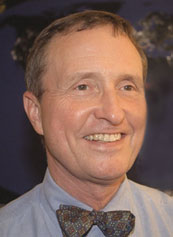Dr. Lovejoy on Climate Change & Biodiversity
 Last week, I added a brief blog post on my research into climate change and biodiversity, emphasizing forest preservation. This evening, I bumped into a video of Dr. Thomas E. Lovejoy discussing similar issues a couple of years ago. Dr. Lovejoy has long been among the most important scientific voices on biodiversity and he has focused on the impact of climate change in recent years. The 35-minute video offers a very nice "plain English" primer on some of the key scientific and policy issues, which I thought Biolaw readers might enjoy.
Last week, I added a brief blog post on my research into climate change and biodiversity, emphasizing forest preservation. This evening, I bumped into a video of Dr. Thomas E. Lovejoy discussing similar issues a couple of years ago. Dr. Lovejoy has long been among the most important scientific voices on biodiversity and he has focused on the impact of climate change in recent years. The 35-minute video offers a very nice "plain English" primer on some of the key scientific and policy issues, which I thought Biolaw readers might enjoy.The bit of the talk that I find most interesting relates to facilitating biodiversity adaptation to inevitable climate change:
Dr. Lovejoy notes that the disassembly and reassembly of biological communities, given differing rates of species migration, will bring “with it a whole host of conservation challenges that it is almost impossible to manage at this point.”
He continues, however, (around 17:00 of the video), “but, basically, if there’s a single recipe here, it’s to restore connection to the landscape, reverse our way of looking at the situation as nature being fenced-off in nice little human-dominated landscapes, and begin to think of ourselves in just the opposite way, as humans living and pursuing our aspirations within a natural matrix.”
He then emphasizes the value of protected areas – primarily as a means of facilitating the migration of species and reassembly of ecological communities.

Other notable points include Dr. Lovejoy advocating short-term use of nuclear energy and stressing the need for social agreement on greenhouse gas concentration targets (rather than emissions targets).
Dr. Lovejoy notes that the disassembly and reassembly of biological communities, given differing rates of species migration, will bring “with it a whole host of conservation challenges that it is almost impossible to manage at this point.”

He continues, however, (around 17:00 of the video), “but, basically, if there’s a single recipe here, it’s to restore connection to the landscape, reverse our way of looking at the situation as nature being fenced-off in nice little human-dominated landscapes, and begin to think of ourselves in just the opposite way, as humans living and pursuing our aspirations within a natural matrix.”
He then emphasizes the value of protected areas – primarily as a means of facilitating the migration of species and reassembly of ecological communities.

Other notable points include Dr. Lovejoy advocating short-term use of nuclear energy and stressing the need for social agreement on greenhouse gas concentration targets (rather than emissions targets).
Labels: EAL












0 Comments:
Post a Comment
<< Home